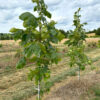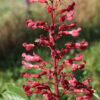As we reach the time of year of peak autumn leaf color, it seems only appropriate that we turn to one of our most colorful native deciduous trees, the American sweetgum (Liquidambar styraciflua). Liquidambar is a small genus of trees, comprising around 15 species with distribution in east and Southeast Asia, eastern North America, and the western Mediterranean. Both the botanical and common name of the tree refer to the sweet, resinous, pale-yellow sap exuded from the tree when cut. From fossil records, the genus arose approximately 95 million years ago. Liquidambar was traditionally considered a member of the witch-hazel family (Hamamelidaceæ). Modern molecular phylogeny (the study of the genetic and protein markers of living organisms) has shown the while related to witch-hazels, Liquidambar itself is the sole genus of the family Altingiaceæ. Interestingly, Altingiaceæ is named for a genus of trees, Altingia, which has been found by modern studies to be synonymous with Liquidambar. Such are the complexities of biological relationships and classifications as our understanding increases!
Our native sweetgum is a very common inhabitant of lower elevations from Connecticut south to central Florida and west to east Texas and southern Illinois. It is a common pioneer species of fallow fields in the southeast United States. There are also scattered native populations in the highlands of eastern México and Central America. The tree is not found at higher elevations of the Appalachians or the upper Midwest as the seeds and young seedlings are killed by the winter cold in those areas. Young trees planted in those areas, however, will thrive as the tree is very resistant to cold after the first couple of years of life. In its native range, sweetgum is a relatively quick grower, maturing at a height of 15–20 m (50–70 ft), with individuals reaching as tall as 45 m (150 ft). Given space, it typically sports an upright-oval crown. The leaves are star-shaped, with 5 (occasionally 3 or 7) sharply-pointed lobes and superficially resemble some maples, but are easily distinguished by their shiny, leathery texture and their alternate attachment to the stem (versus opposite in maples). These leaves are a favorite food of many moth species caterpillars, including the promethea silkmoth (Callosamia promethea) and the luna moth (Actias luna). Liquidambar is often one of the last trees to leaf out in spring…and along with the oaks, one of the last to drop foliage in autumn. The autumn color is nothing short of spectacular, with shades of red, crimson, gold, orange, and purple, often on the same tree.
The bark of American sweetgum is grayish-brown and deeply furrowed, with rough, interlacing ridges that become paler with age. Young twigs sport corky bark after the first year; the distinctive perpendicular attachment of the young bark is the source of another old common name for the species, ‘alligatorwood’. The separate male and female flowers are borne soon after leaf emergence. The male flowers appear as an upright pyramid of small ball-like blooms in red, green, and yellow at the terminals of shoots while the spherical female flowers emerge below the leaves. The female flowers mature to a spiky, woody spherical aggregate of beaked capsules, commonly termed ‘gumballs’. Each capsule contains one or two small, winged seeds that are dispersed by the wind. The spiky, woody gumballs are slow to decay once they fall from the tree, so caution is advised in placement in the landscape as they can be uncomfortable or awkward to walk on. The seeds are a favorite meal for squirrels, chipmunks, and gold (Spinus tristis) and purple (Hæmorhous purpureus) finches.
Sweetgum is an increasingly important timber tree. The wood is close-grained, reddish-brown, and satiny and is often called ‘satin-walnut’ in the trade. It is prone to warping in the drying process but is commonly used as both a plywood component and a veneer in furniture to cover less-desirable woods. The dried resin was used as chewing gum by both Native Americans and pioneers, and also as remedy from sore throats, to protect wounds, and as an adhesive.
For the landscape, Liquidambar styraciflua is a good choice for larger lawns. It provides excellent shade and is unrivalled in fall beauty. It is often not the best choice for lawns used for play or walking due to the spiky fruit, but otherwise is a relatively carefree and pest-free tree. White House Natives has a great selection of very uniform 2” and 2½” caliper sweetgum for fall planting, as well as a few 3” specimens. Give it a shot in your next landscape plan!







